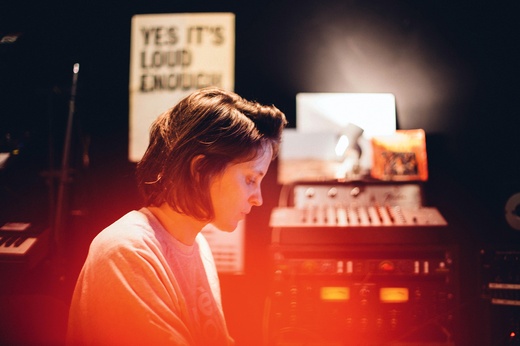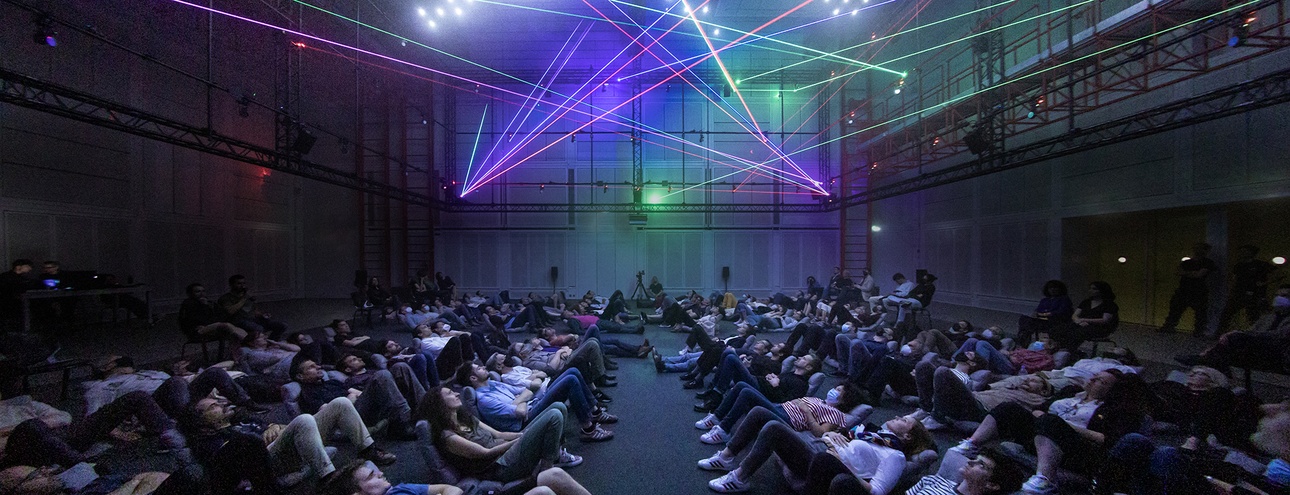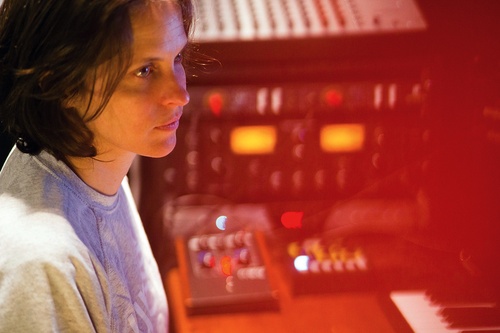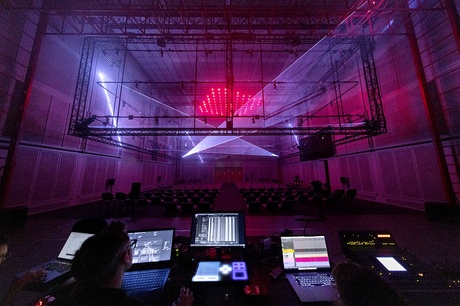Chloé Thévenin en studio
Si Scelci s'invitait chez Xenakis | Enjeux artistiques
 Ressuscité notamment grâce au chercheur de l’Ircam Pierre Carré en 2022, le Polytope de Xenakis connaît aujourd’hui une seconde vie qui transcende à nouveau les frontières, puisque commande a été passée à la compositrice, productrice et DJ CHLOE d’une pièce destinée spécifiquement à ce dispositif. « Je connais bien sûr le travail de Xenakis, dit la DJ. Je ne suis pas forcément familière de toute son œuvre, mais ce génie touche à tout reste une référence très forte dans le milieu de la musique contemporaine, ainsi que sur la scène électro. Personnellement, je suis très touchée par sa manière de combiner mathématiques et poésie. Tout chez lui est extrêmement écrit et précis. Radical et puissant. »
Ressuscité notamment grâce au chercheur de l’Ircam Pierre Carré en 2022, le Polytope de Xenakis connaît aujourd’hui une seconde vie qui transcende à nouveau les frontières, puisque commande a été passée à la compositrice, productrice et DJ CHLOE d’une pièce destinée spécifiquement à ce dispositif. « Je connais bien sûr le travail de Xenakis, dit la DJ. Je ne suis pas forcément familière de toute son œuvre, mais ce génie touche à tout reste une référence très forte dans le milieu de la musique contemporaine, ainsi que sur la scène électro. Personnellement, je suis très touchée par sa manière de combiner mathématiques et poésie. Tout chez lui est extrêmement écrit et précis. Radical et puissant. »
« Quand on m’a approchée, je ne connaissais toutefois pas le Polytope en particulier. J’en avais vu des vidéos ainsi qu’une installation un peu simplifiée, dans le cadre de l’exposition sur Xenakis à la Philharmonie de Paris. Je suis fascinée par son versant visuel : le Polytope comprend une forte dimension architecturale, qui a aussitôt accroché l’habituée des clubs et des raves que je suis. Cela m’a également renvoyée à SloMo AV, un projet ambient dans lequel j’élabore des sons qui se transforment en direct tandis que quelque chose prend vie sur un écran, dans la façon dont l’image est manipulée, ralentit, et se déforme. À la différence qu’ici, c’est dans un format à 360° ! »
« La réception de cette musique sera très différente de celles dont j’ai l’habitude : allongé ou assis, le public est invité à un voyage, une dramaturgie d’une trentaine de minutes. »
CHLOÉ

Reconstitution du Polytopes à l'Espace de projection de l'Ircam, 2022 © Ircam-Centre Pompidou, photo : Quentin Chevrier
Chloé accueille le défi comme une occasion de sortir de sa zone de confort en termes d’expérimentations compositionnelles, sans pour autant abandonner l’une de ses préoccupations principales d’artiste sonore. « Pour une telle expérience immersive, je crois qu’il faut jouer avec l’impact que les fréquences peuvent avoir sur le corps. Cependant, la réception de cette musique sera très différente de celles dont j’ai l’habitude : allongé ou assis, le public est invité à un voyage, une dramaturgie d’une trentaine de minutes. Je commencerai par exposer des textures, des ambiances, qui se transformeront organiquement par manipulation du spectre. J’ai l’habitude de composer en constituant des banques de sons à partir desquelles je crée, assez intuitivement, des couches et des surcouches sonores évolutives. »
Alors que la compositrice évoque cette nouvelle aventure, le nom d’une autre figure majeure de la musique du XXe siècle jaillit de sa bouche : Giacinto Scelsi. « Je suis fan de Scelsi. Ce qui me touche particulièrement dans sa musique, c’est son travail sur les basses fréquences, la manière dont il les amène, souvent avec des instruments qui évoluent plutôt dans le medium, et la manière dont il les fait évoluer. Faire de la cross synthesis entre du Scelsi et du Xenakis : voilà une démarche qui les ferait sans doute bondir, mais qui ne manque pas d’un certain charme provocateur ! »
Une autodidacte en plein apprentissage | Enjeux technologiques
 S’agissant d’informatique musicale, CHLOE n’en fait pas mystère : elle est complètement autodidacte. Elle travaille pourtant au quotidien avec des outils pointus, à commencer par Ableton Live, et trouve depuis longtemps dans la bibliothèque de logiciels de l’Ircam toute une palette sonore inaccessible autrement. « J’ai beaucoup utilisé Audiosculpt : j’aime cette approche visuelle de la confection et de la manipulation du son, avec toutes ces possibilités de cross synthesis, pour créer des sons hybrides en travaillant sur les partiels à partir d’analyses de sons. J’ai beaucoup appris en me plongeant dans cet outil. Concernant Max, je ne suis pas une grande connaisseuse, mais il m’arrive souvent de reprendre des patchs existants et de les adapter. Depuis l’intégration de Max for Live à Live Ableton, je l’utilise très souvent. »
S’agissant d’informatique musicale, CHLOE n’en fait pas mystère : elle est complètement autodidacte. Elle travaille pourtant au quotidien avec des outils pointus, à commencer par Ableton Live, et trouve depuis longtemps dans la bibliothèque de logiciels de l’Ircam toute une palette sonore inaccessible autrement. « J’ai beaucoup utilisé Audiosculpt : j’aime cette approche visuelle de la confection et de la manipulation du son, avec toutes ces possibilités de cross synthesis, pour créer des sons hybrides en travaillant sur les partiels à partir d’analyses de sons. J’ai beaucoup appris en me plongeant dans cet outil. Concernant Max, je ne suis pas une grande connaisseuse, mais il m’arrive souvent de reprendre des patchs existants et de les adapter. Depuis l’intégration de Max for Live à Live Ableton, je l’utilise très souvent. »
Cette production à l’Ircam est donc l’occasion pour CHLOE de découvrir de nouveaux outils : « Je travaille avec Pierre Carré, qui connaît le Polytope mieux que quiconque. Ayant écouté ma musique, et notamment SloMo AV, il m’a proposé diverses technologies Ircam de design et traitement sonore qu’il pensait pouvoir me convenir. » « On a d’abord cherché des outils pour générer du matériau, et surtout des textures assez riches et planantes, confirme le musicien et chercheur. Ma première idée a été SKataRT, un moteur de synthèse concaténative intégré à Live, dérivé de CataRT. Cela s’apparente à de la synthèse granulaire : à partir d’une banque de sons, SkataRT permet de les découper et les réagencer pour élaborer des textures en contrôlant certaines de leurs caractéristiques (hauteur, densité, inharmonicité…). On s’est également intéressé à Rave, un moteur de synthèse fondé sur l’apprentissage machine, développé par l’équipe Acid : l’idée est d’alimenter un modèle d’IA avec un corpus de sons, pour resynthétiser des textures, voire des figures plus précises, dans un esprit similaire à celui des données utilisées. »


Reconstitution du Polytopes à l'Espace de projection de l'Ircam, 2022 © Ircam-Centre Pompidou, photo : Quentin Chevrier
Cependant, le Polytope étant ce qu’il est, l’un des principaux axes de réflexion concerne la spatialisation sonore. « C’est pour moi totalement nouveau !, s’enthousiasme CHLOE. Rares sont les scènes électro à proposer de la spatialisation. Je compte donc sur mes séances de travail à l’Ircam pour y travailler. Mais la spatialisation ne doit pour moi être envisagée qu’en relation avec des éléments sonores. »
« La version originale du Polytope s’appuyait sur 12 haut-parleurs pour spatialiser dynamiquement 7 canaux audio, explique Pierre Carré. Dans la reconstitution que nous en avons réalisée, nous sommes passés à un réseau de 25 haut-parleurs, mais sans chercher à lisser les discontinuités, en gardant le côté brut caractéristique de Xenakis. Pour permettre à CHLOE de travailler en autonomie, je lui ai présenté des outils qu’elle peut intégrer dans ses sessions Ableton Live. Ces outils n’ont pas la précision et la flexibilité du Spat complet de l’Ircam, mais offrent un bon compromis entre efficacité et facilité d’utilisation. Ils permettront en outre d’implémenter aisément la spatialisation qu’elle aura imaginée au cours de la performance. »
Photo d'illustration et dans le texte : Chloé Thévenin © Alexandre de la Madeleine




